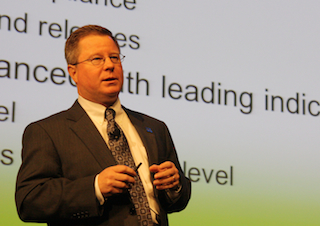
Recognizing that studying past safety lapses is like driving a car while looking through the rearview mirror, Fluor Corp. has launched a company-wide effort this year to look ahead at leading safety indicators on its jobsites.
Speaking at the National Safety Council's annual meeting Oct. 22 in Orlando, Jeffrey G. Ruebesam, Fluor's vice president of corporate health, safety and environment (HSE), said the company wants to become more proactive in stopping accidents before they happen.
"Only learning from what is happening in the past isn't the best way to measure an HSE program," Ruebesam told attendees. Leading indicators "are all about learning faster and solving problems before they become big problems and people get hurt."
Many examples of leading indicators include good planning and execution, such as ensuring workers are adequately trained, initiating task assignments, holding safety meetings and identifying hazards.
Reviewing near-misses, another key leading indicator, is difficult to perform because employees often are afraid to talk about their mistakes. It is an attitude Fluor wishes to change with this new program.
"A lot of companies, including ours, struggle with how do to near-miss reporting well," Ruebesam said. "You've got to overcome the fear factor."
Though Fluor has for years set metrics for leading indicators on some of its roughly 1,000 global jobsites, this is the first time the company has set metrics at the corporate level. This year, Fluor is auditing 100 sites for leading safety indicators. So far, the company has seen a 10% improvement in its audit results since it began the program.
Falls, the leading cause of workplace accidents in the United States, remain one problem area, admitted Ruebesam, a former G.E. executive who joined Fluor last year. While large contractors like Fluor protect workers well at extreme heights, many hazards remain closer to the ground.
For example, tape barricades "don't really get it done" at low heights, Ruebesam told ENR at the safety conference. "I wouldn't want to rely on a piece of tape for a fall that is four to six feet."
The goal, Ruebesam said, is to standardize such indicators, connect projects and build a rich database of best practices. Employees that take the lead will be rewarded, and those that perform poorly may have to answer to a higher authority.
"We tell people, if you do poorly on an audit, you get to get some face time with the chairman," Ruebesam said.


Post a comment to this article
Report Abusive Comment